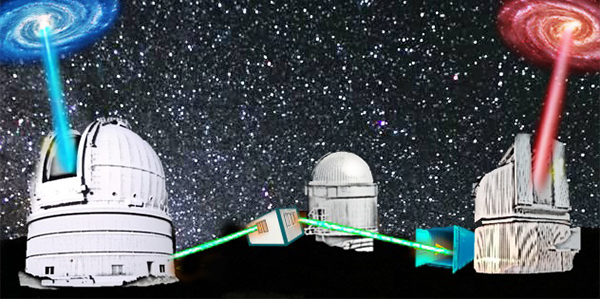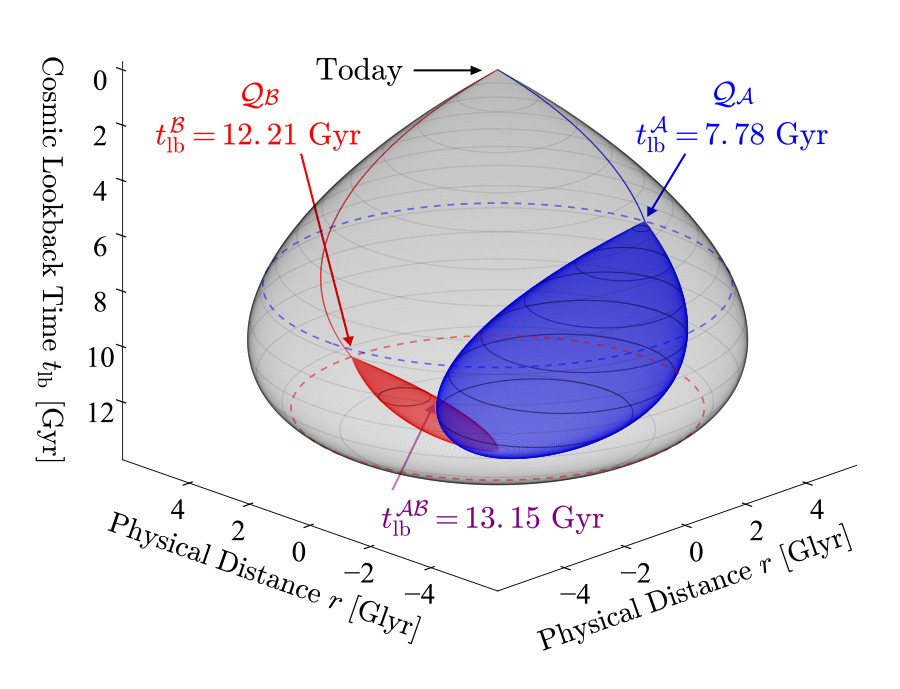Physicists Race to Demystify Einstein’s ‘Spooky’ Science
International research team recasts timeline, dating from the Big Bang, of possible quantum theory alternatives
Published Date
By:
- Cynthia Dillon
Share This:
Article Content
When it comes to fundamental physics, things can get spooky. At least that’s what Albert Einstein said when describing the phenomenon of quantum entanglement—the linkage of particles in such a way that measurements performed on one particle seem to affect the other, even when separated by great distances. “Spooky action at a distance” is how Einstein described what he couldn’t explain.

Schematic of the 2018 “Cosmic Bell” experiment at the Roque de Los Muchachos Observatory in the Canary Islands, where two large telescopes observed the fluctuating color of light from distant quasars (red and blue galaxies). The green beams indicate polarization-entangled photons sent through the open air between stations separated by about one kilometer. Image by Andrew S. Friedman and Dominik Rauch
While quantum mechanics includes many mysterious phenomena like entanglement, it remains the best fundamental physical theory describing how matter and light behave at the smallest scales. Quantum theory has survived numerous experimental tests in the past century while enabling many advanced technologies: modern computers, digital cameras and the displays of TVs, laptops and smartphones. Quantum entanglement itself is also the key to several next-generation technologies in computing, encryption and telecommunications. Yet, there is no clear consensus on how to interpret what quantum theory says about the true nature of reality at the subatomic level, or to definitively explain how entanglement actually works.

Diagram of a run of the Cosmic Bell test. The regions of space and time where an alternative, non-quantum mechanism could still have acted (limited to the red and/or blue regions) corresponds to at least 7.78 billion years ago (blue region). Light from the more distant quasar was emitted 12.21 billion years ago (red region). Compared to the gray region, representing all of space and time prior to the experiment, the alternatives are limited to within four percent of the space-time volume since the Big Bang. Image by Andrew Friedman and David Leon
According to Andrew Friedman, a research scientist at the University of California San Diego Center for Astrophysics and Space Sciences (CASS), “the race is on” around the globe to identify and experimentally close potential loopholes that could still allow alternative theories, distinct from quantum theory, to explain perplexing phenomena like quantum entanglement. Such loopholes could potentially allow future quantum encryption schemes to be hacked. So, Friedman and his fellow researchers conducted a “Cosmic Bell” test with polarization-entangled photons designed to further close the “freedom-of-choice” or “free will” loophole in tests of Bell’s inequality, a famous theoretical result derived by physicist John S. Bell in the 1960s. Published in the Aug. 20 issue of Physical Review Letters, their findings are consistent with quantum theory and push back to at least 7.8 billion years ago the most recent time by which any causal influences from alternative, non-quantum mechanisms could have exploited the freedom-of-choice loophole.
“Our findings imply that any such mechanism is excluded from explaining the results from within a whopping 96% of the space-time volume in the causal past of our experiment, stretching all the way from the Big Bang until today,” said Friedman. “While these alternatives to quantum theory have not been completely ruled out, we are pushing them into a progressively smaller corner of space and time.”
In their experiment, the researchers outsourced the choice of entangled photon measurements to the universe. They did this by using the color of light that has been traveling to Earth for billions of years from distant galaxies—quasars—as a “cosmic random number generator.”
“This is a rare experiment that comes along only very seldomly in a scientist’s career: a pioneering experiment that sets the bar so high few, if any, competitors can ever match it,” noted UC San Diego astrophysicist Brian Keating. “I’m so proud that my graduate student David Leon had the chance to make a significant contribution to this fascinating research, co-led by CASS research scientist, Dr. Andrew Friedman.”
Besides UC San Diego’s Friedman and Leon, the full research team included lead author and Ph.D. student Dominik Rauch, along with Anton Zeilinger and his experimental quantum optics group from the University of Vienna; theoretical physicists David Kaiser and Alan Guth at MIT; Jason Gallicchio and his experimental physics group at Harvey Mudd College, and others. Expanding upon their previous quantum entanglement experiments, Friedman and colleagues went to great effort to choose entangled particle measurements using 3.6 and 4.2 meter telescopes in the Canary Islands, allowing them to collect sufficient light from the much fainter, distant quasars.
To conduct their test, they shined laser light into a special crystal that generated pairs of entangled photons, which the scientists repeatedly sent through the open air toward both telescopes. From the quasar light collected, the scientists could choose polarization measurement settings while each entangled photon was in mid-flight. The group was allotted three nights and a few hours at the Roque de los Muchachos Observatory in La Palma, amidst operationally challenging conditions including freezing rain, high winds, and uncertainty about whether they would have enough time to complete the experiment. Additionally, Friedman and colleagues had to write software that could choose the best quasars to observe on-the-fly—from a database of more than 1.5 million—and predict the observation time needed to obtain a statistically significant result.
“We pushed to the limit what could be done within the time constraints,” said Friedman. “The experiment would not have been possible without an amazing international collaboration. It was a roller coaster experience to see it actually work.”
The research was funded by the Austrian Academy of Sciences; The Austrian Science Fund with SFB F40 (FOQUS) and project COQuS (W1210-N16); the Austrian Federal Ministry of Education, Science and Research; the University of Vienna (via the project QUESS); the National Science Foundation INSPIRE Grant (PHY-1541160); the U.S. Department of Energy (DE-SC0012567); the U.S. Department of Defense, through the National Defense Science & Engineering Graduate Fellowship Program, and UC San Diego’s Ax Center for Experimental Cosmology.
UC San Diego, prefers the path less traveled. And it has led to remarkable new ways of seeing and making a difference in the world. The university was recently ranked #2 for quality education at an affordable price by Money magazine. Additionally, the Academic Ranking of World Universities lists UC San Diego #15 in the world and #13 nationally.
Share This:
Stay in the Know
Keep up with all the latest from UC San Diego. Subscribe to the newsletter today.



